|
+GIRL
STUFF+
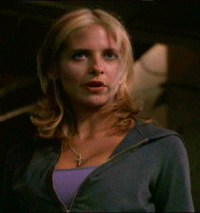 "Date.
Shop. Go to school, hang out, save the world from unspeakable
demons -- I wanna do all that girl stuff." - Buffy, 'Faith,
Hope and Trick' "Date.
Shop. Go to school, hang out, save the world from unspeakable
demons -- I wanna do all that girl stuff." - Buffy, 'Faith,
Hope and Trick'
MISOGYNISTIC
HORROR
Feminism has associations of hairy-armpitted
women burning stuff and generally refusing to have anything to do with
men. Obviously, feminism isn't really about that. It's about seeing the
world from a female perspective, and of seeing things in terms of the inequalities
of gender. In Buffy the Vampire Slayer, Joss Whedon started from a feminist
idea; taking an established stereotype (the modern horror genre) where
women are typically the victims, and reversing it. The horror genre was
always misogynistic; the basic idea was that women had to remain pure,
and to have sex was punishable. In 'Halloween', that's the whole plot;
the heroine survives because she doesn't shag. No shag, no die. The genre
was all about punishing women, and having them seem feeble and helpless:
"I created Buffy the Vampire Slayer
as a movie a long time ago to protect the blonde girl in the alley who
always got killed. One of the distinguishing features of the blonde girl
in the alley who always got killed is that she actually had sex. She always
seemed to be punished for it, and I thought it wasn't fair - so Buffy was
created as a sort of stereotype buster, on that level." - Joss Whedon
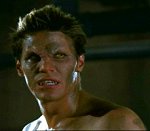
Whedon's idea was to change that;
the girl that isn't bound by the genre stereotypes of horror. Rather than
having a male figure, usually a 'psychopath', as the powerful figure, with
some sort of moral authority, this time the girl in the alley fights back.
While the horror genre had pretended to condemn the psycho figure, really
it invested him with all the power to control the plot: and the power of
life and death over characters. In Buffy, the heroine isn't running from
the male killer, she's chasing him. Buffy doesn't reverse the stereotype,
because that would simply mean a 'Fatal Attraction'-style female psycho;
instead, Buffy hits back at the horror genre from within. Buffy is the
champion of all the helpless women running from the men.
SHAGGED
AND KILLED
Often, however, stereotypes are
deliberately reversed. In the episode 'Teacher's Pet', the shag-then-die
plot isn't exactly played out, but it's Xander's sexual urges which lead
to him getting nearly shagged and killed. Buffy saves him and kills the
giant shapechanging preying mantis, as you do. The difference here, however,
is that the psycho-killer is also the seductress; in some ways it seems
like female sexual desire is being punished. Okay, so the preying mantis
wants to mate with Xander then eat his brains, which isn't exactly very
nice, but the point is the same.
It's in Season 2 when the feminism
really comes into play, when Joss Whedon really tackles the punished-for-sex
stereotype. Buffy sleeps with Angel, and Angel turns bad. It seems at first
glance that sex is being punished in the classic horror way. In reality
Whedon is playing out a common occurrence from real life, and exaggerating
it. Girl and boy have sex, then boy casts girl aside. But Buffy hits back;
she kicks the crap out of Evil Angel.
"This show's designed to be a feminist
show. Not a polemic, but a very straight-on feminist show, and
for her to be so abused by him, and for her response to be to
kick him in what Spike would refer to as the 'goolies'... it's
very primal, it's very important, it's kinda empowering and
I kinda love it." - Joss Whedon
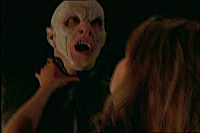
BLOWING
UP THE HIGH SCHOOL
What Whedon does time and time
again in the show is take high school life, and blow it up into demonic,
physical proportions. 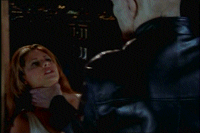 But he always takes it from a female perspective.
All the male characters in the show are ultimately in the power of female
characters; Giles is a father figure but on a basic physical level he's
always proved to be far weaker than Buffy. Equally Xander is always buffeted
around by women - Buffy, Cordelia, the big preying mantis thing. The big
bads of the seasons tend to be men (the Master, Angel, the Mayor, Adam),
and all are summarily dealt with. The Master, simply from his name, was
an embodiment of the Dracula-like power over women, and Buffy had to overcome
him to truly become a Slayer. The Mayor turned into a big penis-like demon
which Buffy killed, a recurring theme in the show. Adam was an Incredible
Hulk-style ubermensch, a symbol of male physical power. Buffy kicked his
arse, but only with the aid of her friends. Joss Whedon's feminism isn't
a self-contained anti-men ideology, it includes the likes of Xander, Oz
and Giles; neither of whom are exactly butch. But he always takes it from a female perspective.
All the male characters in the show are ultimately in the power of female
characters; Giles is a father figure but on a basic physical level he's
always proved to be far weaker than Buffy. Equally Xander is always buffeted
around by women - Buffy, Cordelia, the big preying mantis thing. The big
bads of the seasons tend to be men (the Master, Angel, the Mayor, Adam),
and all are summarily dealt with. The Master, simply from his name, was
an embodiment of the Dracula-like power over women, and Buffy had to overcome
him to truly become a Slayer. The Mayor turned into a big penis-like demon
which Buffy killed, a recurring theme in the show. Adam was an Incredible
Hulk-style ubermensch, a symbol of male physical power. Buffy kicked his
arse, but only with the aid of her friends. Joss Whedon's feminism isn't
a self-contained anti-men ideology, it includes the likes of Xander, Oz
and Giles; neither of whom are exactly butch.
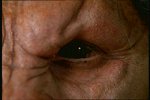 However
these male characters are always shown to have a dark side; Oz and Willow
were a couple not dissimilar to Buffy and Angel. But with Oz, the dangerous,
feral side was something to be contained; the idea was that it was through
Willow that Oz could overcome his wolfy self. Later, Oz breaks from Willow
and tries to master his inner beast alone. He fails because he can't overcome
his feelings for her; the anger which brings out his werewolf side comes
from his inability to deal with Willow and Tara's relationship. Similarly
Xander and Giles have both shown dark sides; Xander once turned into a
were-hyena ('The Pack'), and another time becomes a vampire (in 'The Wish');
both times Buffy either saves or kills him. Giles' 'Ripper' alter-ego is
a tough, more manly side which has to be restrained. However
these male characters are always shown to have a dark side; Oz and Willow
were a couple not dissimilar to Buffy and Angel. But with Oz, the dangerous,
feral side was something to be contained; the idea was that it was through
Willow that Oz could overcome his wolfy self. Later, Oz breaks from Willow
and tries to master his inner beast alone. He fails because he can't overcome
his feelings for her; the anger which brings out his werewolf side comes
from his inability to deal with Willow and Tara's relationship. Similarly
Xander and Giles have both shown dark sides; Xander once turned into a
were-hyena ('The Pack'), and another time becomes a vampire (in 'The Wish');
both times Buffy either saves or kills him. Giles' 'Ripper' alter-ego is
a tough, more manly side which has to be restrained.
WOMEN
= POWERFUL
Similarly, women are powerful.
Willow starts off in the show as a shy character in the power of Xander;
though the years she has progressed to be possibly the most powerful of
the whole Scooby Gang. Anya is an obvious feminist character in the form
of a man-torturing demon; but while she does lose her powers, she is the
one to make the first moves with Xander, and the more dominant in the relationship.
Cordelia is obviously poweful, in a bitch-queen type way. In Angel the
series she is the person from whose visions most of the plot develops,
with power over the other characters.

Angel was, for a time, the only
male character to get under Buffy's skin, and have real emotional power
over her. In Season 3, Angel had to return helpless so that Buffy could
be the powerful one again. It could be said that Angel is castrated; certainly
he is effectively a eunuch, while Buffy is free to shag as she pleases.
In the show there's always an emphasis on emotional strength; it's not
enough for Buffy to be physically strong, she has to be emotionally tough;
so when she was hurt by Parker, in Season 4, she had to come back from
it without just the use of violence. But Whedon always makes Buffy
a 'normal girl'; he's always careful not to make her into Faith, a solitary
character without long-term relationships of any kind.
In this lies much
of the show's genius; Buffy isn't like Xena, she's a normal
girl. Joss Whedon creates a character which is both physically
and emotionally strong, as well as a young girl with ordinary
desires. "The two things that matter the most to me in the work
I do; emotional resonance, and rocket launchers," Joss Whedon
says in the DVD commentary to 'Innocence'. In other words, Whedon
wants Buffy to be a character people can relate to and empathize
with (whether we're male or female), as well as a super-chick
fighter of evil men.
+LINKS+
Buffy
the Patriachy Slayer
A
collection of articles which look at Buffy from a feminist angle.
|
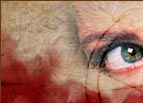

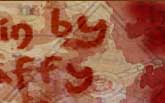
 "Date.
Shop. Go to school, hang out, save the world from unspeakable
demons -- I wanna do all that girl stuff." - Buffy, 'Faith,
Hope and Trick'
"Date.
Shop. Go to school, hang out, save the world from unspeakable
demons -- I wanna do all that girl stuff." - Buffy, 'Faith,
Hope and Trick' 

 But he always takes it from a female perspective.
All the male characters in the show are ultimately in the power of female
characters; Giles is a father figure but on a basic physical level he's
always proved to be far weaker than Buffy. Equally Xander is always buffeted
around by women - Buffy, Cordelia, the big preying mantis thing. The big
bads of the seasons tend to be men (the Master, Angel, the Mayor, Adam),
and all are summarily dealt with. The Master, simply from his name, was
an embodiment of the Dracula-like power over women, and Buffy had to overcome
him to truly become a Slayer. The Mayor turned into a big penis-like demon
which Buffy killed, a recurring theme in the show. Adam was an Incredible
Hulk-style ubermensch, a symbol of male physical power. Buffy kicked his
arse, but only with the aid of her friends. Joss Whedon's feminism isn't
a self-contained anti-men ideology, it includes the likes of Xander, Oz
and Giles; neither of whom are exactly butch.
But he always takes it from a female perspective.
All the male characters in the show are ultimately in the power of female
characters; Giles is a father figure but on a basic physical level he's
always proved to be far weaker than Buffy. Equally Xander is always buffeted
around by women - Buffy, Cordelia, the big preying mantis thing. The big
bads of the seasons tend to be men (the Master, Angel, the Mayor, Adam),
and all are summarily dealt with. The Master, simply from his name, was
an embodiment of the Dracula-like power over women, and Buffy had to overcome
him to truly become a Slayer. The Mayor turned into a big penis-like demon
which Buffy killed, a recurring theme in the show. Adam was an Incredible
Hulk-style ubermensch, a symbol of male physical power. Buffy kicked his
arse, but only with the aid of her friends. Joss Whedon's feminism isn't
a self-contained anti-men ideology, it includes the likes of Xander, Oz
and Giles; neither of whom are exactly butch.
 However
these male characters are always shown to have a dark side; Oz and Willow
were a couple not dissimilar to Buffy and Angel. But with Oz, the dangerous,
feral side was something to be contained; the idea was that it was through
Willow that Oz could overcome his wolfy self. Later, Oz breaks from Willow
and tries to master his inner beast alone. He fails because he can't overcome
his feelings for her; the anger which brings out his werewolf side comes
from his inability to deal with Willow and Tara's relationship. Similarly
Xander and Giles have both shown dark sides; Xander once turned into a
were-hyena ('The Pack'), and another time becomes a vampire (in 'The Wish');
both times Buffy either saves or kills him. Giles' 'Ripper' alter-ego is
a tough, more manly side which has to be restrained.
However
these male characters are always shown to have a dark side; Oz and Willow
were a couple not dissimilar to Buffy and Angel. But with Oz, the dangerous,
feral side was something to be contained; the idea was that it was through
Willow that Oz could overcome his wolfy self. Later, Oz breaks from Willow
and tries to master his inner beast alone. He fails because he can't overcome
his feelings for her; the anger which brings out his werewolf side comes
from his inability to deal with Willow and Tara's relationship. Similarly
Xander and Giles have both shown dark sides; Xander once turned into a
were-hyena ('The Pack'), and another time becomes a vampire (in 'The Wish');
both times Buffy either saves or kills him. Giles' 'Ripper' alter-ego is
a tough, more manly side which has to be restrained.
